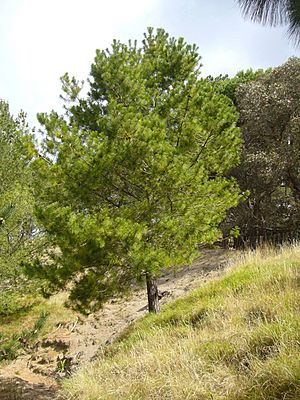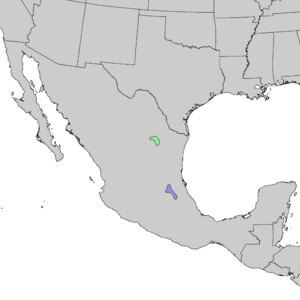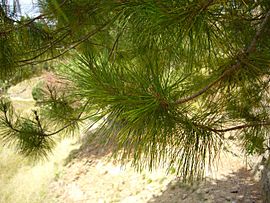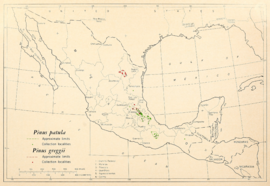Gregg's pine facts for kids
Quick facts for kids Gregg's pine |
|
|---|---|
 |
|
| Conservation status | |
| Scientific classification | |
| Genus: |
Pinus
|
| Species: |
greggii
|
 |
|
| Natural range: Green: Pinus greggii var. greggii Blue: Pinus greggii var. australis |
|
Gregg's pine, also known as Pinus greggii, is a type of pine tree. It grows in eastern Mexico. These trees are usually small to medium in size. They have a loose, open top and long, thin branches. Their needles grow in groups of three. They are about 11 centimeters long. The cones often grow in groups of 5 to 10. The upper part of the trunk and the branches are smooth. Gregg's pine has also been planted in many other countries.
Contents
Understanding Gregg's Pine: Taxonomy
The scientific name for Gregg's pine is Pinus greggii. This tree was first described by a scientist named George Engelmann in 1868.
Scientists sometimes talk about two different types, or varieties, of Gregg's pine:
- Pinus greggii var. australis
- Pinus greggii var. greggii
The name greggii was chosen to honor Josiah Gregg. He was an explorer and writer. He lived from 1806 to 1850. Josiah Gregg explored parts of the American Southwest and Northern Mexico.
What Gregg's Pine Looks Like
Gregg's pine is a small to medium-sized tree. It can grow to be about 15 to 20 meters tall. That's like a building with 5 to 7 floors!
Bark and Branches
The bark of young Gregg's pine trees is smooth. As the tree gets older, the bark at the bottom becomes rough. It has deep cracks and rough, long plates. The bark on the upper trunk and branches stays smoother. It is usually grayish-brown.
The top part of the tree, called the crown, is loose and open. The branches are long and thin. They can sway in the wind. Young branches are a bluish-green color.
Needles and Cones
The needles are bright, shiny green. They are usually 7 to 15 centimeters long. They grow in bundles of three. Each bundle has a short base.
The pollen cones are small. They are about 1.5 to 2 centimeters long. They are yellowish and turn yellowish-brown.
The seed cones are quite large. When open, they are 6 to 15 centimeters long. They are light brown when they are ready. These cones are often curved and have an irregular shape. They grow in groups of 5 to 10 on the branches.
Gregg's pine trees start making flowers and cones when they are about 4 or 5 years old. The cones are ready in December and January. This is about 21 months after the tree is pollinated.
Gregg's pine is very similar to another tree called Pinus patula. They can even be cross-bred. The main difference is in their needles. Pinus patula has longer, drooping needles. Their bark also looks different.
Where Gregg's Pine Grows
Gregg's pine is found in Mexico. It grows in a mountain range called the Sierra Madre Oriental. You can find it in specific states like Coahuila, Nuevo León, and Hidalgo.
Its natural home is a bit further north than its close relative, Pinus patula. Their growing areas overlap a little. Scientists have different ideas about whether these two pines naturally create mixed trees. Some say they do, and that people have also successfully mixed them. Others say natural mixed trees have not been seen.
Gregg's pine grows in two separate areas in Mexico. There's a northern group in Coahuila and Nuevo León. There's also a southern group in Puebla, San Luis Potosí, Hidalgo, Querétaro, and Veracruz. These two groups are about 360 kilometers apart. The trees from these two areas have slight differences in their needles, cones, and seed sizes. They also grow in slightly different environments.
Gregg's Pine in its Natural Home
Gregg's pine likes to grow in cool mountain areas. It is found at heights between 1,300 and 2,600 meters. In the northern part of its range, it grows even higher, from 2,300 to 2,700 meters.
The amount of rain it gets each year is usually 600 to 800 millimeters. However, in some parts, like along the Hidalgo-Veracruz border, it gets more rain, up to 1,000 to 1,600 millimeters. In the north, it often grows in slightly alkaline soils. In the south, it prefers acid soils.
This tree does not handle frost very well. But it can survive a little bit of frost if it happens where it grows at its highest points. The climate in these Mexican mountains is usually quite humid.
Gregg's pine is not found everywhere in large numbers. It usually grows mixed with other trees. These include oaks, sycamores, sweetgums, ash trees, and other pines. Some of these other pines are Pinus patula, P. pseudostrobus, P. teocote, P. montezumae, and P. arizonica. In drier spots, it grows with P. cembroides and Juniperus flaccida. In higher, wetter places, it grows with Abies vejarii, Pseudotsuga menziesii, or Cupressus lusitanica.
Growing Gregg's Pine in Other Countries
Between the 1960s and 1980s, Gregg's pine from the southern population was brought to about 10 subtropical countries. Later, in the late 1980s, both northern and southern types were tested in places like Brazil, Colombia, New Zealand, South Africa, and Zimbabwe.
These tests led to some plantations being started. For example, about 1,000 hectares are planted each year in South Africa. Gregg's pine has also been introduced to Italy, India, Nepal, and Argentina.
See also
 In Spanish: Pino prieto para niños
In Spanish: Pino prieto para niños




